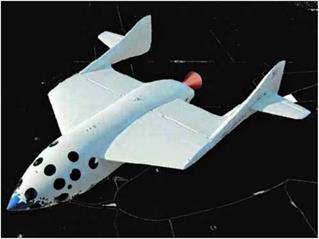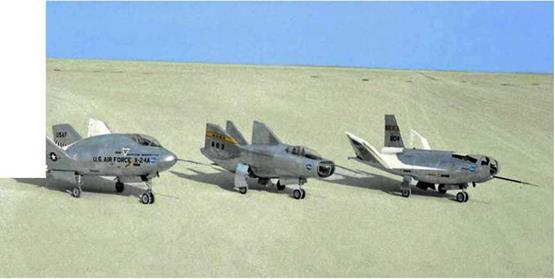SpaceShipOne Construction
|
A |
t the front of SpaceShipOne’s stout fuselage, many small portholes take the place of a conventional canopy or windshield, giving the vehicle its truly far-out look. As shown in the views in figure 4.1 and figure 4.2, the twin tail booms are another of the spaceship’s most distinguishing features. In terms of function, however, SpaceShipOne’s feather mechanism is unique among all aircraft and spacecraft. The forward half of each wing is fixed, but the rear halves, including the tail booms, fold upward for reentry.
The appearance of SpaceShipOne bears resemblance to aspects of several pioneering rocketcraft. The bullet-shaped fuselage appears very similar in shape to the Bell X-1, shown in figure 4.3. However, the X-l itself shares a common shape with the V-2 rocket, which was initially modeled after a rifle bullet. The use of a delta wing and stabilizers at the wingtips is also reminiscent of NASA’s early lifting bodies, as shown in figure 4.4.
Burt Rutan’s innovative use of composites took shape in the 1970s when he built his second aircraft, theVariEze. Now with SpaceShipOne, an aircraft so radically different in function, purpose, and performance, Rutan and the Scaled Composites team had to tap deep into their expertise. And when this wasn’t sufficient, they had to risk taking a leap. Their decades of experience with the manufacturing of strong, lightweight composite aircraft would be tested to the limits, because so much of the design and construction was brand-new territory. So how does one go about building a spaceship? This is a question that wouldn’t have


г ; ^
Fig. 4.1. Among SpaceShipOne’s most distinct features are the round windows on its bullet-shaped nose, the outboard tail booms at the wingtips, and the thick, swept-back wings mounted high on the fuselage. Mojave Aerospace Ventures LLC, photograph by Scaled Composites
__________________ J
( ^
Fig. 4.2. At a length of 28 feet (8.5 meters), SpaceShipOne is shorter
than the Bell X-1, the very first X-plane. However, the width of SpaceShipOne, the distance between the tips of the horizontal stabilizers on the tail booms, is 27 feet (8.2 meters), which is comparable in size to the wingspan of the X-1. Mojave Aerospace Ventures LLC, photograph by Scaled Composites
V_____________________________________ J
r ; л
 Fig. 4.3. Parked in front of the B-29 mothership, the X-1 was built by Bell Aircraft Corporation for the U. S. Army Air Forces and the National Advisory Committee for Aeronautics, the predecessors of the U. S. Air Force and NASA, respectively. The X-1 ‘s revolutionary use of structures and pioneering aerodynamic shapes and controls enabled Chuck Yeager to become the first to break the sound barrier, flying faster than Mach 1. NASA-Dryden Flight Research Center
Fig. 4.3. Parked in front of the B-29 mothership, the X-1 was built by Bell Aircraft Corporation for the U. S. Army Air Forces and the National Advisory Committee for Aeronautics, the predecessors of the U. S. Air Force and NASA, respectively. The X-1 ‘s revolutionary use of structures and pioneering aerodynamic shapes and controls enabled Chuck Yeager to become the first to break the sound barrier, flying faster than Mach 1. NASA-Dryden Flight Research Center
к__________ J
г ; л
 Fig. 4.4. Known as lifting bodies because they were considered wingless, the rocket-powered X-24A, M2-F3, and HL-10 (left to right) dropped from a B-52 to explore the possibility of returning from space in an unpowered glide. Up until then, spacecraft had only returned from space using parachutes, and the data obtained by these vehicles helped pave the way for the Space Shuttle. NASA-Dryden Flight Research Center
Fig. 4.4. Known as lifting bodies because they were considered wingless, the rocket-powered X-24A, M2-F3, and HL-10 (left to right) dropped from a B-52 to explore the possibility of returning from space in an unpowered glide. Up until then, spacecraft had only returned from space using parachutes, and the data obtained by these vehicles helped pave the way for the Space Shuttle. NASA-Dryden Flight Research Center
к )
—
Table 4.1 Size Comparisons for Rocketcraft
|
SpaceShipOnea |
X-1 |
X-15b |
Space Shuttle |
|
|
Length |
28 feet |
30.9 feet |
51 feet |
122.2 feet |
|
(8.5 meters) |
(9.4 meters) |
(15.5 meters) |
(37.2 meters) |
|
|
Wingspan |
16.4 feet |
28 feet |
22 feet |
78.1 feet |
|
(5.0 meters)c |
(8.5 meters) |
(6.7 meters) |
(23.8 meters) |
|
|
Height |
8.8 feet |
10.8 feet |
13 feet |
56.6 feet |
|
(2.7 meters) |
(3.3 meters) |
(4.0 meters) |
(17.3 meters) |
|
|
Weightd |
7,937 pounds |
12,250 pounds |
38,000 pounds |
242,000 pounds |
|
(3,600 kilograms) |
(5,557 kilograms) |
(17,237 kilograms) |
(110,000 kilograms) |
|
a: For last spaceflight of SpaceShipOne. b: For modified X-15A-2 without drop tanks. c: SpaceShipOne’s width of 27 feet (8.2 meters) is its widest dimension. d: Gross weights are given except for the Space Shuttle, which is given for landing weight. v______________________________________ ____________________________________ J |
an answer until SpaceShipOne was ready for flight testing. Even then, after each step forward and envelope expansion, it was necessary to make modifications or refinements to overcome the technical challenges that waited in the wings.










